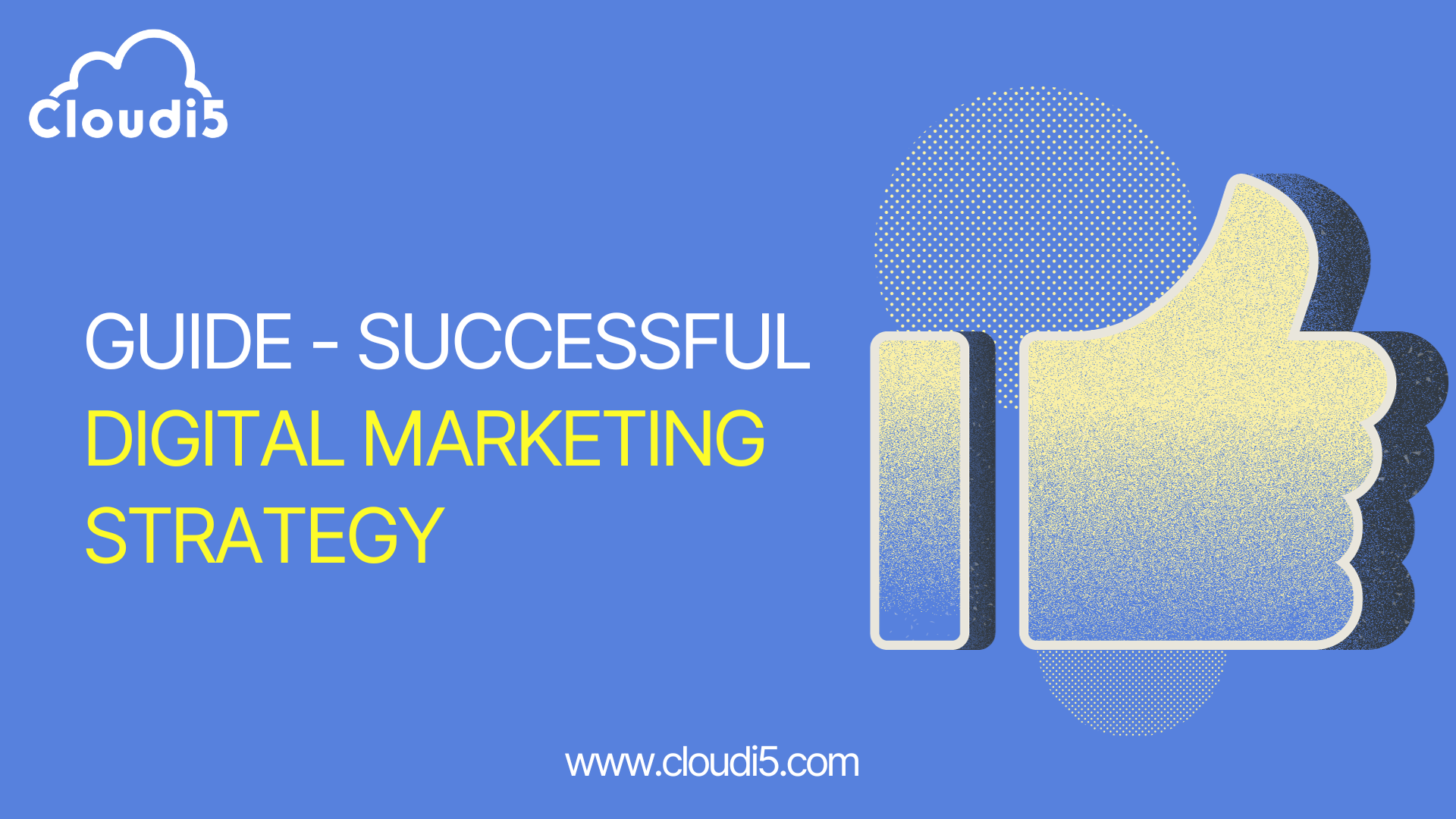
The Ultimate Guide To Creating A Successful Digital Marketing Strategy
Welcome to the beginning of your journey to learning the art of digital marketing! A strong internet presence is critical for business success in today's fast-paced environment. Starting The Ultimate Guide to Creating a Successful Digital Marketing Strategy is your ticket to mastering the ever-changing world of digital marketing. Choosing digital marketing as a career allows individuals to use their creativity, analytical skills, and the ever-changing digital landscape to generate significant strategies for organizations in a variety of industries.
Discover the secrets, master the tools, and develop an impactful plan that takes your business to new heights in the digital sphere. Prepare to discover the tactics that will revolutionize your internet presence and catapult your business growth!
Understanding the Fundamentals
In today's competitive marketplace, digital marketing services comprise a wide range of strategic strategies and technologies aimed to maximize online presence, engage consumers, and produce real outcomes for businesses. A well-crafted digital marketing plan is the crux of success for organizations of all sizes in the fast-paced digital economy. Its importance stems from its capacity to shape a brand's online appearance, attract target audiences, and create meaningful conversions.
A digital marketing strategy is a detailed plan that describes how a company or organization will use various online channels, platforms, and methods to reach specified marketing objectives and goals. It is a structured method that incorporates several digital marketing elements in order to successfully interact with the target audience, drive engagement, and, eventually, accomplish desired results.
Goals and objectives: Specific, measurable aims that digital marketing initiatives strive to achieve, such as growing brand awareness, driving website traffic, generating leads, or increasing sales.
Identification of the Ideal Customer Profile: A thorough grasp of the ideal customer profile through demographics, habits, interests, and pain areas. This insight informs the development of targeted campaigns and content.
Channel Selection and Planning: Choosing the most relevant online channels and platforms (e.g., social media, search engines, email marketing, content marketing) based on the target audience and business goals.
Content Strategy: Creating and distributing valuable, relevant, and consistent content across several digital channels in order to engage and nurture the audience throughout their buyer's journey.
SEO and Paid Advertising: Strategies for optimizing content and websites for search engines (SEO) in order to improve visibility, as well as incorporating paid advertising campaigns (PPC, display advertisements) for quick reach and conversions.
Social Media Strategy: Developing a strategy for engaging with the audience on social media platforms, establishing community, and driving engagement and conversions.
Conversion Rate Optimization (CRO): Using strategies to improve the user experience, optimize landing pages, and fine-tune marketing aspects in order to increase conversions.
Analytics and Measurement: Analytics and measurement are the processes of defining metrics and employing analytical tools to track and assess the performance of digital marketing efforts, allowing for data-driven insights and informed decision-making for continuous development.
A well-crafted digital marketing strategy combines these elements to form a roadmap that corresponds with overall business objectives, maximizes online visibility, and creates meaningful engagement and conversions in the digital environment.
Research and Analysis:
In the area of successful digital marketing, market research and audience analysis serve as guiding beacons. They act as a guidepost, directing firms toward a better understanding of consumer needs, behaviors, and preferences. Market research reveals industry trends and rival strategies, providing a comprehensive picture of the market landscape. At the same time, audience analysis looks into the subtle nuances of the ideal client profile, revealing their motives and pain concerns. With this information, firms can create bespoke, targeted campaigns that resonate profoundly with their target demographic. Businesses can drive engagement, conversions, and long-term connections with their audiences by coordinating tactics based on extensive research, setting the framework for long-term success in the digital realm.
Competitor analysis is a potent technique that helps to power the engine of a more effective digital marketing plan. Businesses acquire critical insights into what works and what doesn't within their industry landscape by evaluating competitor tactics, strengths, weaknesses, and market positioning. This analysis reveals novel methods, effective advertising, and developing patterns that can either inspire or warn strategic decisions. Furthermore, by learning from the successes and failures of competitors, businesses may fine-tune their own strategies, maximize marketing efforts, and remain ahead of the competition, ensuring a more informed and agile approach to attaining their goals.
Crafting content and SEO strategy:
The dynamic synergy between content planning and search engine optimization (SEO) is the foundation of all effective digital marketing efforts. A well-defined content strategy focuses on producing high-quality, valuable, and relevant information for the target audience. Across multiple digital channels, this content seeks to address their problems, provide solutions, or deliver entertaining information.
SEO, on the other hand, focuses on improving visibility and ranking higher in search engine results by optimizing content and website features. Keyword research, on-page SEO, and link building are critical components of this process since they ensure that content fits with search engine algorithms and user intent.
The important interaction between the two is in creating content that both captivates human readers and appeases search engine algorithms. A strategic content approach organically blends relevant keywords into useful, captivating content, making it more discoverable and appealing to both people and search engines. By optimizing content features like meta tags, headings, and URL structures according to SEO best practices, the content becomes more accessible and enticing to search engine crawlers.
Leveraging social media and paid advertising:
Social networking sites:
Brand Visibility: Creates a strong online presence that promotes brand familiarity and visibility among a large audience.
Engagement and Community Building: Allows for direct connection with customers, the cultivation of relationships, and the creation of a sense of community around the brand.
Content Distribution: Allows for the distribution of various content types (pictures, videos, and tales) in order to capture and resonate with the target audience.
Audience Insights: Provides useful data and insights about audience behavior, preferences, and feelings, assisting in the refinement of marketing campaigns.
Paid marketing channels:
Targeted Reach: Enables precision targeting based on demographics, interests, and behaviors, ensuring that messages are delivered to the most relevant audience segments.
Immediate Visibility: Provides immediate exposure and visibility, effectively generating traffic and conversions.
Customizable Budgets: Provides budget allocation flexibility, allowing organizations to optimize spending and maximize return on investment.
Measurable Outcomes: Provides precise analytics and performance indicators, allowing for continuous adjustment and refinement of advertising campaigns.
Social media and paid advertising channels complement each other in enhancing brand presence, engaging audiences, and driving targeted activities, and are essential components of a full digital marketing plan.
Measuring and analyzing performance:
In the world of digital marketing, analytics serves as a compass to guide strategic decisions. It entails gathering and interpreting data from digital platforms in order to assess the efficacy of marketing initiatives. Analytics enables organizations to evaluate initiatives by providing indicators such as website traffic, user activity, and conversion rates. These analytics enable marketers to optimize campaigns, distribute resources intelligently, and modify methods for optimum impact in the evolving digital marketplace.
The following are critical metrics and tools to consider for this purpose:
Conversion Rate: The percentage of users who complete the targeted action, such as making a purchase, signing up for a newsletter, or downloading material. It demonstrates the efficiency of the campaign in achieving the desired results.
Click-through rate: The ratio of users who clicked on a certain link or ad to the total number of users who viewed it is shown as the click-through rate (CTR). CTR reflects the campaign's relevancy and involvement.
Return on Investment (ROI): calculates the revenue generated in relation to the campaign's cost. It is responsible for determining the profitability and efficiency of marketing investments.
Bounce Rate: The percentage of visitors that abandon a website after just seeing one page. A high bounce rate could indicate irrelevant information or a bad user experience.
Engagement Metrics: Metrics such as likes, shares, comments, and time spent on page are examples of engagement metrics. These metrics assess audience engagement and interest in the material.
Tools for Tracking and Analytics:
Google Analytics is a robust and free tool for tracking website traffic, user behavior, conversions, and other information. Google Analytics is a critical tool for digital marketers since it provides insights into website traffic, user activity, and the effectiveness of online initiatives. Google Analytics is quite useful in digital marketing training.
Platforms that provide detailed insights and information on ad performance, such as CTR, impressions, conversions, and cost per click (CPC), such as Google Ads and Facebook Ads Manager.
Marketing Automation Platforms: Tools such as HubSpot, Marketo, and Mailchimp provide in-depth statistics for email marketing campaigns, lead creation, and customer engagement.
Social Media Insights: Platforms such as Facebook Insights, Twitter Analytics, and LinkedIn Analytics provide information on audience demographics, interaction, and content performance.
Heatmap Tools: Services like Hotjar and Crazy Egg provide visual representations of user interactions on websites, assisting in the understanding of user behavior and the optimization of the user experience.
Using a combination of these critical metrics and technologies allows marketers to thoroughly review campaign effectiveness, acquire insights into audience behavior, and make data-driven decisions to optimize tactics for superior results in the digital marketing landscape.
Conclusion:
In conclusion, "The Ultimate Guide to Creating a Successful Digital Marketing Strategy" has been an eye-opening voyage into the diverse world of digital marketing. This guide has provided a complete roadmap for building meaningful strategies, from grasping the complexities of audience segmentation to leveraging the power of multiple digital channels and delving into the depths of analytics. Businesses may increase brand awareness, engagement, and meaningful conversions by embracing the interaction of content strategy, SEO, social media, paid advertising, and analytics.
Trusted By












Leave Comments